The Ultimate Ecommerce Accountant's Guide to Search Engine Optimization (SEO)

If you’re an ecommerce accountant looking to increase your website’s organic traffic, then you’re in the right place.
This SEO guide is a pretty comprehensive one.
The goal of this guide is to make sense of SEO best practice, as it relates to ecommerce specialist accountants and their websites.
It is split into the elements that make up a strong brand entity online, and it goes deep and technical - that is, if you want it to.
TABLE OF CONTENTS
With expanding sections for greater depth, you can immerse yourself in as much or as little of the granular detail as you have the time (and motivation) for.
We’ll explain what's most important and what’s less so, so that if you want to stick to the topline and avoid marketing spiel where possible, we've got you.
NB: We'll be referring to Google as a representative "search engine" in this guide.
Your Introduction to SEO
Search Engine Optimization is all about great user experience.
The most important thing to know about Search Engine Optimization is that it’s an ongoing process. You’re never really done with it.
To be successful with SEO, you need to be as active and evolving as search engine users.
You need to understand what they are looking for and where, how they communicate, interact with your site, and what drives them both to engage with or move on from you.
If you can nail SEO, the traffic that you get to your website should not only increase, but be the right traffic with the intention to find an accountant like you - all without costing you a cent in advertising.
Sound good? It is, but it does take some work.
Search engines like Google want to give their users the best experience.
If you get great at defining which users you are the best experience for, it will get better at directing them your way and not towards your competitors.
In other words, once you have your niche within the specialist accounting space, you’ll be able to target focused users more likely to want your service.
So how does Google rate your site among your competitors?
One way to think of your website is like a tree.
In order for it to be fruitful, i.e., generate lots of new search leads and potential customers, it needs a few robust elements all working together:
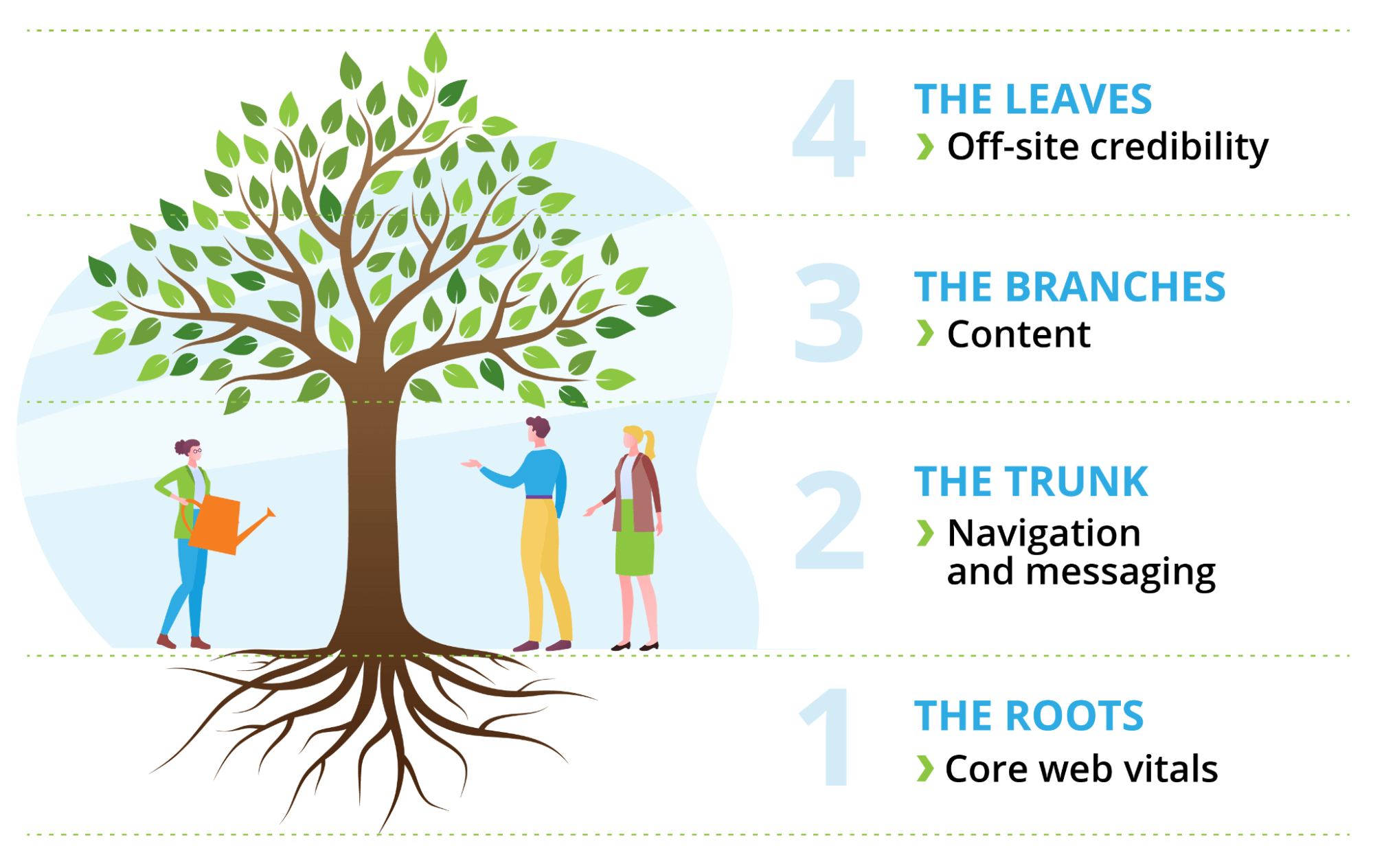
The stronger your elements are, the more attractive a hub your website is - both for search engines, and for ecommerce sellers looking for you.
Today, Google is all about entities when it comes to SEO - not just one or two great blogs about bookkeeping methods or accounting software choices.
It’s looking at the entire tree.
So a holistic approach is more important now than ever.
By optimizing each element of your tree, we’ll be covering off the three types of SEO:

Don’t worry, we’ll tackle these in bitesize chunks, with plenty of examples and instructions for applying them to your own site.
Let’s start with the roots of the tree, it’s performance and visibility - or its “core web vitals”.
The Roots: Core Web Vitals
TECHNICAL SEO

“Core web vitals” is the technical term for three key measurables on your website that Google takes notice of.
Think of them like the structural foundations of your site.
These impact your site’s loading time, visual stability and interactivity, which in turn, affect user experience.
These measurables are LCP, FID and CLS.
You can still rank with poor core web vitals, if other elements of your website are great. But for the best results, don’t leave these out.
After all, you know how frustrating it is when you have to wait for webpages to load.
To set up your website analytics for measuring your core web vitals, and the other elements of SEO that this guide will explore, follow our steps below.
We’ll also explore those three measurables above and what you can do to improve them.
Disclaimer: These will be different based on your hosting platform.
What you do for a WordPress site won’t look the same as for Squarespace.
But there are some tools that you can set up to help you diagnose what might be compromising your core web vitals, regardless of platform. And these also help you measure the impacts of the other steps we go through in this guide.
These instructions are the most technical in our guide, but they are invaluable in providing you with actionable insights and performance data for ongoing SEO efforts.
We’re going to set up and link Google search console and Google analytics accounts for your site.
-
Head to the Google Search
Console, create a login, and add
your site.
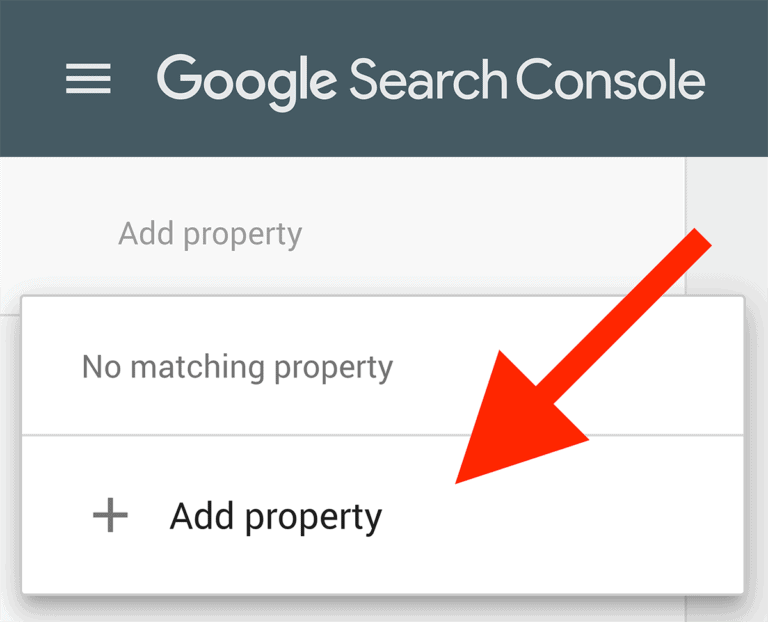 Source:
Backlinko.
Source:
Backlinko.
- You’ll need to copy your website’s URL into the Domain section.
-
Now, you’ll need to verify your
site. You can do this in a few
different ways, so we’ll pick
one here. Select
HTML tag, and
add that code to your website’s
homepage code.
Make sure you are on your homepage. Once you find your code via the steps below, add the HTML tag to your page’s head section of code.
For PC users:
- Chrome: CTRL + U, or open your menu (the three straight lines) and navigate to Tools > View Source.
- Internet Explorer: CTRL + U, or right click and select View Source.
- Firefox: CTRL + U, or navigate to Firefox > Web Developer > Page Source.
- Opera: CTRL + U, or right click and select View Source.
For Mac users:
- Safari: Option+Command+U, or right click and Show Page Source.
- Chrome: Option+Command+U, or navigate to View > Developer > View Source, or right click to View Page Source.
- Firefox: Command+U, or right click and select Page Source, or head to Tools > Web Developer > Page Source.
-
Next you want to tell Google which country’s traffic you are targeting, in order to get the most specific and relevant performance data.
To do that, head to Search Traffic > International Targeting. Open the Country tab, and check the Target Users In box. Choose your country from the drop-down menu.
- Now you want Google to tell you which keywords your site is ranking for, as well as where your traffic is coming from. This involves linking your search console profile to Google Analytics.
- Once into Google Analytics, head to Admin > Property Settings > Adjust Search Console. Click Add, find your website, check the box, and select Save.
-
Now that your search console and
analytics profiles are linked,
you should start to see the
following metrics:
Impressions Clicks Click-through rate (CTR) Position by country Keywords The number of views a piece of content or ad generated. The number of clicks a piece of content or ad generated. The rate at which your impressions turned into clicks. Where are you ranking highest in global search results? The keywords and phrases bringing people to your site. -
We’ll talk more about these
metrics later. Right now, we
want to check on your current
core web vitals state. Back in
the search console, select Core
Web Vitals.
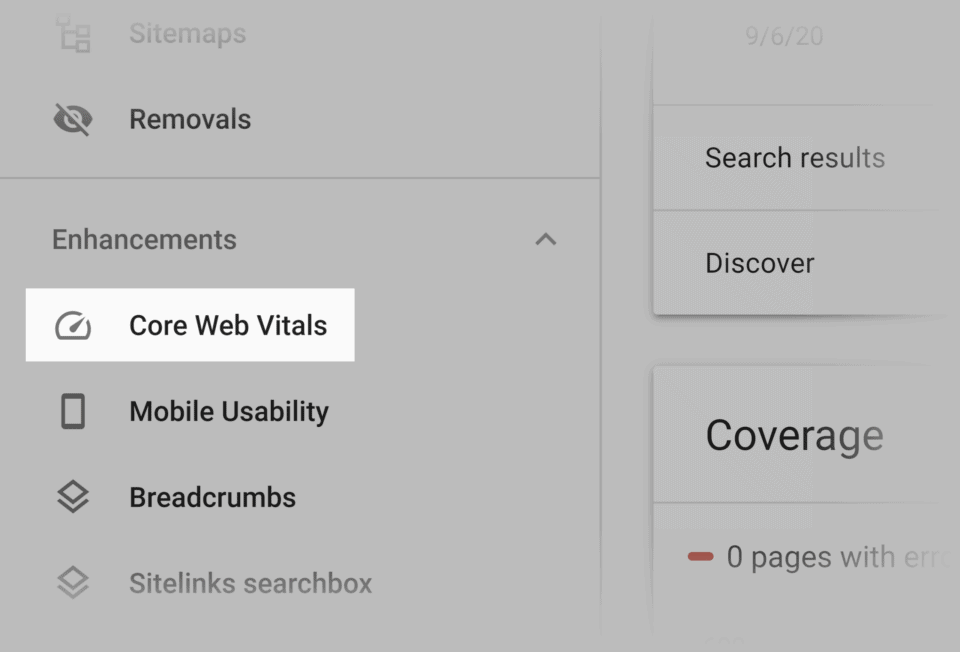 Source:
Backlinko.
Source:
Backlinko.
-
You’ll see charts showing your site’s current performance. “Poor URLs” should be your greatest concern.
The console will tell you the issue that needs fixing. For example, below, it is a “CLS issue”, which impacts the visual stability of those pages:
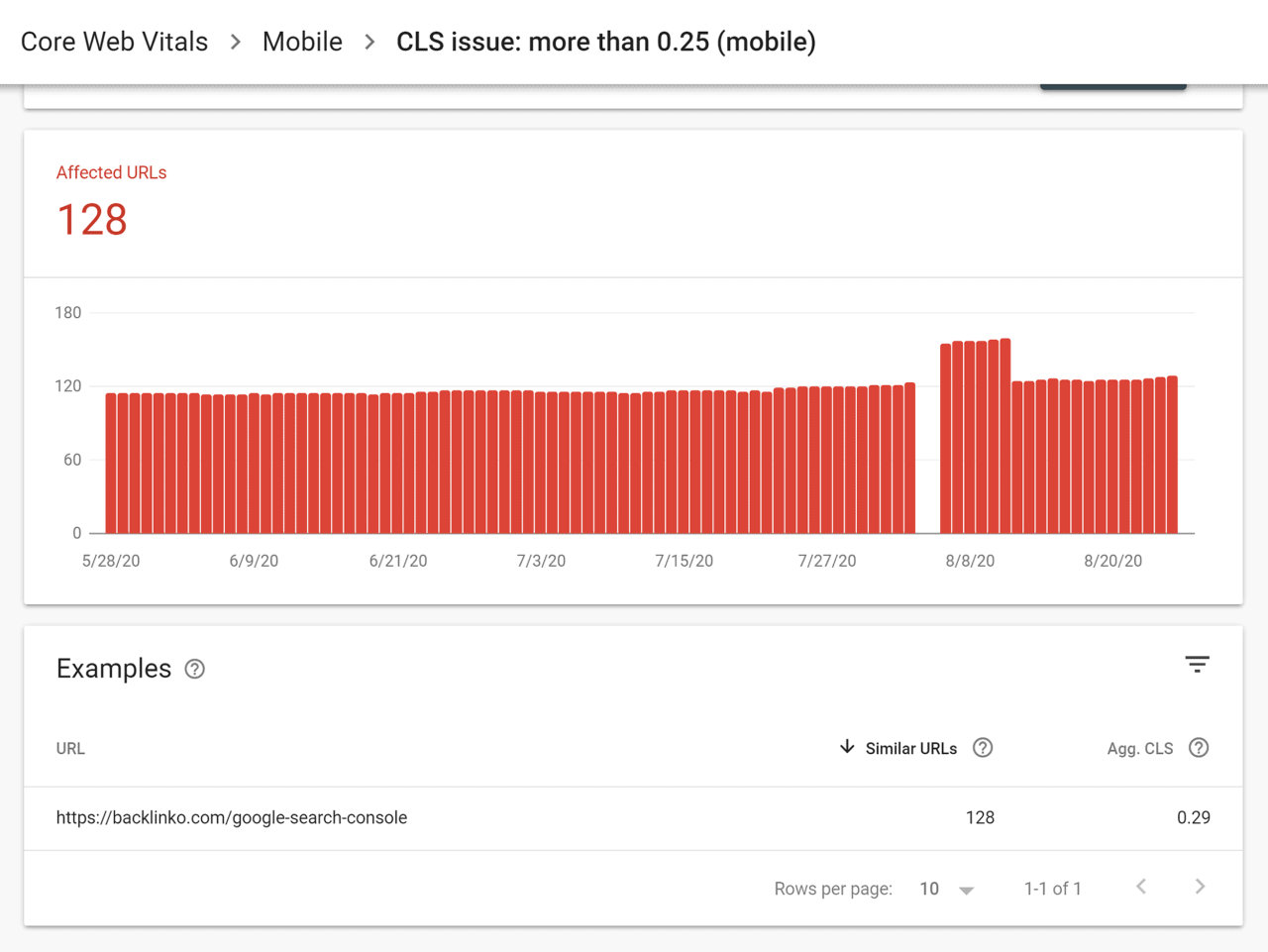 Source:
Backlinko.
Source:
Backlinko.
You’ll need to work your way through the improvements that Google suggests in its console. It may be a time-consuming process, but this is the best way to improve your core web vitals.
In the introduction of this section we introduced the three key metrics for strong core web vitals.
Here, we’ll talk about what they mean in a practical sense, and how you can ensure that your website is a great place for prospective customers to spend time.
The three core web vitals:
|
LCP Largest Contentful Paint |
This impacts your site’s loading time. |
|---|---|
|
FID First Input Delay |
This impacts your site’s interactivity. |
|
CLS Cumulative Layout Shift |
This impacts your site’s visual stability. |
Optimizing these things ensures a great user experience, and one that Google is more likely to rank highly in the search results.
And remember, these won’t necessarily bomb your search results rankings, either. So if you’re completely overwhelmed - or put off - by the instructions coming, that’s ok. You can either seek expert help or work on improving the other, less technical areas of your site.
But for those adventurous sorts, let’s crack on.
The main tool you’ll want, aside from Google Search Console, is Google PageSpeed Insights.
This will show you
your core web vitals
performance in one
place:
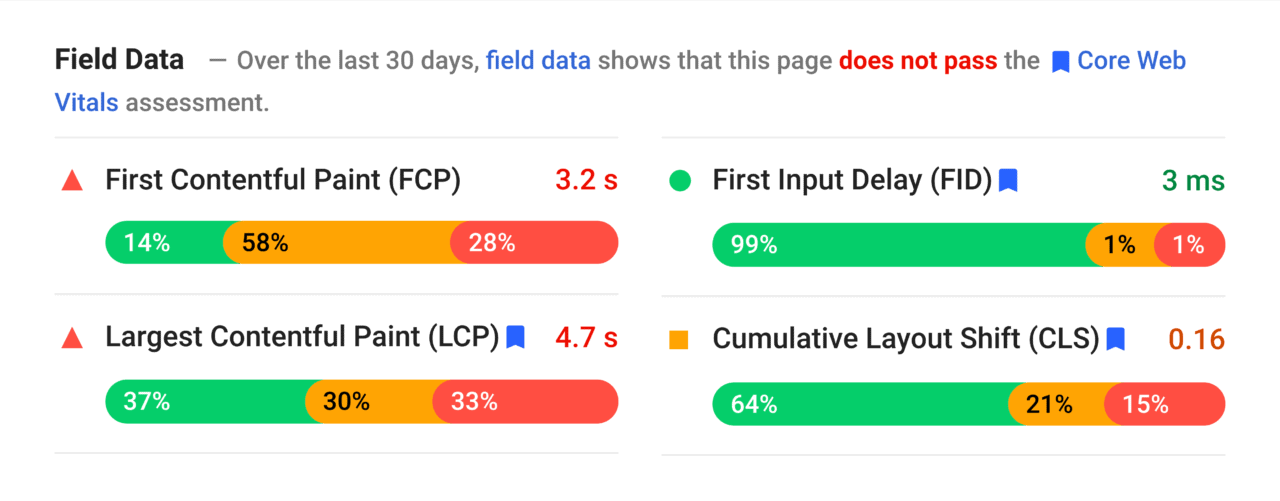 Source:
Backlinko.
Source:
Backlinko.
Optimizing your LCP (or page speed)
The LCP refers to the time it takes for all the content on your page to load for a visitor.
In 2001, a study found that visitors would wait up to 8 seconds for pages to load. By 2008, that had reduced to 5.1 seconds and today, it’s nearer 2.
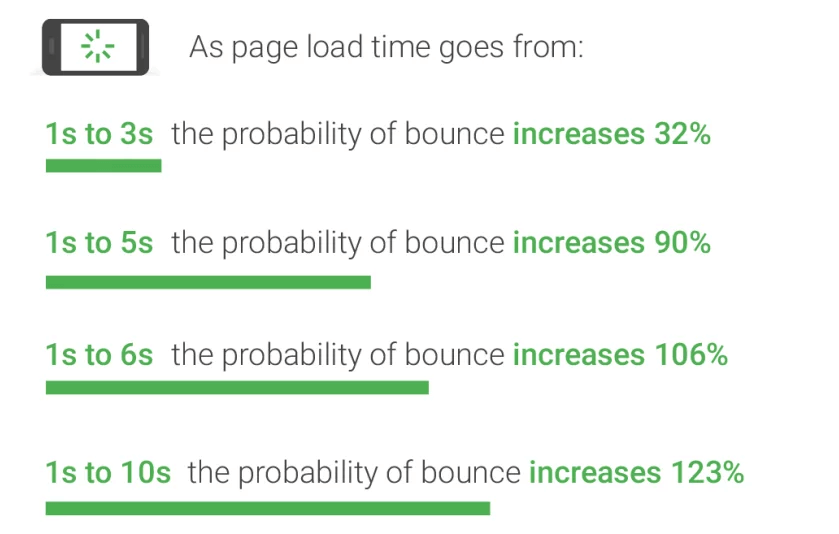 Source:
Neil Patel.
Source:
Neil Patel.You can lose prospects a few times over from slow loading speeds - not only will that first visitor bounce back to Google, but Google takes note of your “bounce rate” and sends less people to you in the first place.
So let’s fix it.
- The Google Search Console is better for LCP improvements. It shows you the performance of all your website’s pages in one place, and categorizes them as “Good”, “Needs Improvement”, and “Poor”.
- You want all of your pages to reach the state of LCP in 2.5 seconds. This can be hard for pages that contain lots of media.
- Upgrading your website’s host may result in faster loading times.
- Using lazy loading, which is when images only load as the user scrolls down to them, helps reduce the heavy lifting of loading media-rich pages.
- Removing or reducing larger elements. The search console will identify this problematic content.
- Cleaning up your code. If you want to get technical, minifying your CSS can help improve LCP. This is simply cleaning your code of white spaces, unnecessary indentation and other redundant elements. There are tools to do this for you.
Optimizing your FID (or page interactivity)
After page loading speed comes the time it takes for a visitor to interact with your page.
This interaction might be clicking a link to another page, filling in a form, or opening a navigation menu item.
For pages of blog content, the First Input Delay isn’t so relevant, since you want users to read rather than interact with it in most cases.
But if the page contains a form you want users to fill out, the time that it takes your site to allow them to do this hugely impacts user experience.
Here are some tips to improve FID:
- Looking into minimizing or deferring the JavaScript on the page. This process may depend on the website platform you use, so instructions to do this will vary.
- Remove any unnecessary third-party scripts, if applicable.
- Opt for a browser cache. This is like a record of page interaction so that a lot of the loading doesn’t need to be replicated again later on.
Optimizing your CLS (or page stability)
The Cumulative Layout Shift, or CLS of your page, refers to how stable it is as it loads content.
Have you ever spotted something on a webpage, attempted to click it but it moved away just as you got there? Maybe you were sent somewhere else as a result?
Yeah, that’s annoying. And that’s CLS.
If elements on your page shift around a lot as it loads, causing users to have to spend longer finding what they want, then CLS is high. And high CLS is bad.
Google measures these in the same way as LCP and FID, with “Good” (up to 0.1), “Needs Improvement” (0.1 - 0.25) and “Poor” (0.25+).
Things you can try when it comes to improving your CLS score:
- Assign dimension attributes to media on your page (like videos). This helps a browser understand what is on your page, how big it is, and make space accordingly as it loads.
- Give any advertisements a dedicated space. This avoids them pushing other content out the way.
- Add any new user interface elements, like buttons or interactive content, further down the page so that it doesn’t mess with what a user expects to land on first.
Hopefully you can see that optimizing your core web vitals is just about great, frictionless user experience.
And that’s all Google wants to provide to its searchers.
And if you’re still confused by all this, or you’re intrigued and want to know more, Google has a great guide to help you further: Basics of UX.
It’s also, incidentally, the theme of our next section.
The Trunk: User Experience
ON-PAGE SEO

Search Engine Optimization is all about helping Google recognize how great your site is at delivering answers to search queries in a seamless way.
If someone searches for “US ecommerce specialist accountants for Shopify”, and that’s you, then you want to rank ahead of your competitors.
But you need to prove yourself to your visitors and by extension, to Google. And its algorithms have evolved enough to look for signals of great UX (user experience) on your site.
So, what are these signals? And how can you optimize for them?
That’s what this section is all about.
In order for a visitor to stay on your site, it needs content and pages to be a few things.
They need to be relevant, current, easy to read and navigate, and quick to load and respond.
These all make up a great user experience.
Below are the key metrics that Google uses to measure whether you are likely providing a great user experience.
For each, we have provided the key things you can work on to improve, and expandable sections for a deeper dive into how.
Core web vitals
| Factors that make up your site’s core web vitals | ||
|---|---|---|
| LCP (page speed) | FID (page interactivity) | CLS (page stability) |
Ah, huh! Core web vitals again.
If you’ve read that section already, you’ll understand why these measures are so important to user experience.
They’re not important enough to go through again though, so if you haven’t already, check out the section dedicated to them for optimization tips.
Search intent
| Types of search intent that should guide your content | |||
|---|---|---|---|
| Information? | Navigation? | Commercial? | Transaction? |
Why are people searching what they’re searching for?
Are they looking for information, direction, services or to buy something?
In the world of ecommerce, this could be things like:
- Free resources to learn the ropes of ecommerce accounting.
- Sales tax advice and information for compliance.
- Recommendations of great accounting software specific to ecommerce needs.
- The services of a specialist accountant for a longer term solution.
Those first three things are more educational and information, whilst the last is transactional.
These different needs require a different approach. And if you take appropriate action, all of these things can lead to new clients.
Uncovering why your visitors are searching certain keywords can help you ensure that you are Google’s best option for answering those queries.
Steps to satisfying the search intent behind your chosen keywords:
-
Uncover
what it
is. Most
search terms
fall
into the
following
categories, which can
help you
with your
approach.
Check out some example keyword search terms that may fall into these categories:
Informational Navigational Commercial Transactional “Ecommerce business plan content”
“Sales tax compliance for ecommerce”
“VAT changes June 2021”
“A2X accountant directory”
“Ecommerce accountant LinkedIn”
“A2X Facebook”“Free trial accounting software”
“Best accounting software for Amazon”
“Best tax apps for Shopify”“Ecommerce accountant near me”
“Amazon specialist ecommerce accountant”
“Accountants to manage tax compliance”
Once you have some understanding of why the user searched that keyword, take a look at the pages already ranking highly on Google.
They have met and passed its vetting process - how have they done it?
Are they typically lists, blogs, videos, case studies, reports, downloadables, audio, or something else? Let this guide your own strategy.
-
Optimize user experience. Pogo-sticking is when a user opens one search result, doesn’t find their answer so returns and opens another, repeating this process until they find what they want.
Google doesn’t want this. It’s not good UX, and it suggests the pages ranked aren’t satisfying search intent. This will lead to lower rankings for those pages.
Here are ways to avoid that and improve search UX:
- Limit pop-ups. They’re not popular with people or with search engines. A good approach is to only use them if a visitor is about to leave your page.
- Use large fonts. Fonts less than 12pt may be difficult for some users to read, encouraging them to pogo-stick.
- Use headings and subheadings. People often want to skim information, this lets them do that rather than leaving your page.
- Use other media. Videos are a great way for people to get information quickly, as are infographics and images. Google likes a variety of media, too.
-
Improve your existing content. Is it really answering the search intent as well as the top-ranked pages on Google?
The People Also Ask questions are a fantastic resource for inspiration about what people want to know about the topic as well. Here are some for the keyword “best accounting software”:
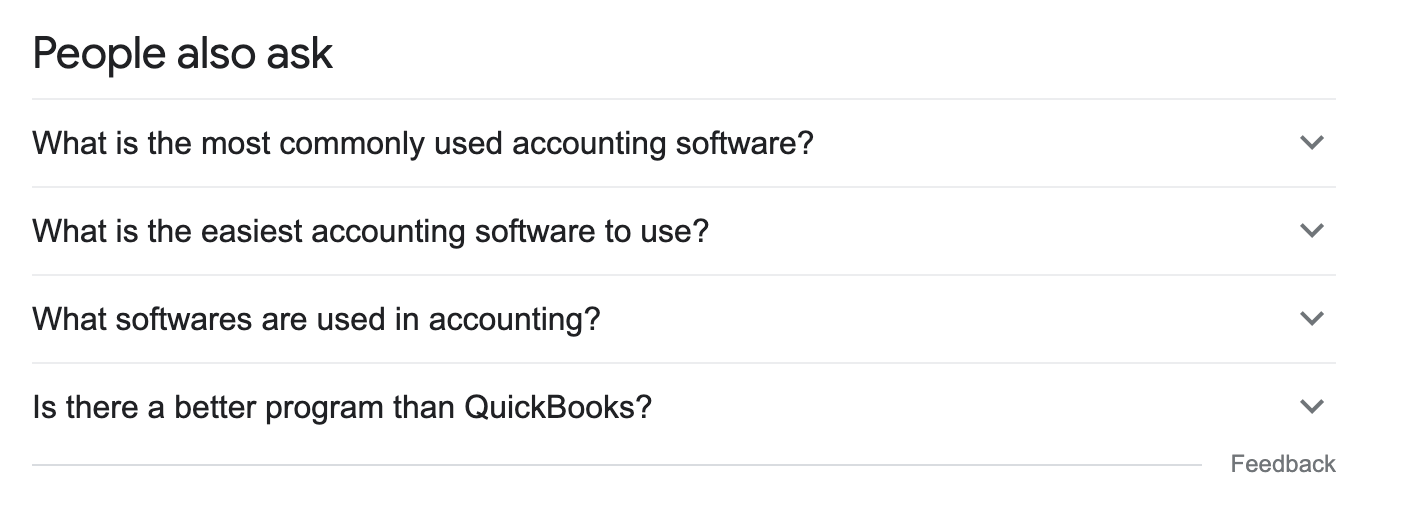
-
Optimize your commercial pages too. Sometimes people aren’t looking for content, they are looking for quotes or opportunities to sign up to something.
There is such a thing as multiple intents for one keyword.
The best thing you can do if you come across this situation is pick one, and stick to it.
Organic CTR
| Factors that can increase your click-through rate | ||||
|---|---|---|---|---|
| The current year in the page title | Numbers in the page title | Brackets in the page title | Compelling meta description | Short, simple URLs |
Organic click-through rate (CTR) is the number of people that click on a search engine result (that wasn’t boosted by an ad).
Your SEO strategy should be all about getting your website ranking highly on Google, and tempting searchers to click on it. If you didn’t want that, you wouldn’t be reading this guide.
A high CTR is a doubly good thing. It means you have lots of traffic, and it signals to Google that people like you, and it should rank you more highly.
Here are some tips for getting those visitor numbers up:
- Include the current year in your page title. This helps show your users and Google that your page is relevant right now. (Just make sure that it is!)
- Include numbers in your page title (where appropriate). This could be “Top 10 software choices for eBay sellers”, or “25% off accounting services for your first month”, or “We’ve helped 1000 businesses increase their margins”.
-
Use brackets in your title meta tag. Meta titles and descriptions are the ones you see on Google’s search results page. They’re crucial, because they are what a browser judges your page on. Brackets are a great way to give readers further insight into what’s on the page.
Hubspot found that clicks increased around 40% for titles that used brackets to sneak a peek at what the content was.
We at A2X use these in our own blogs, e.g. How To Sell on Amazon in 2021 (The Ultimate Guide), and QuickBooks Amazon Integration Guide [How to Set It Up].
-
Make
your
URLs
shorter.
That’s
right, even
URLs impact
users and
Google
rankings.
For example,
our guide on
Etsy SEO has
the
following
title:
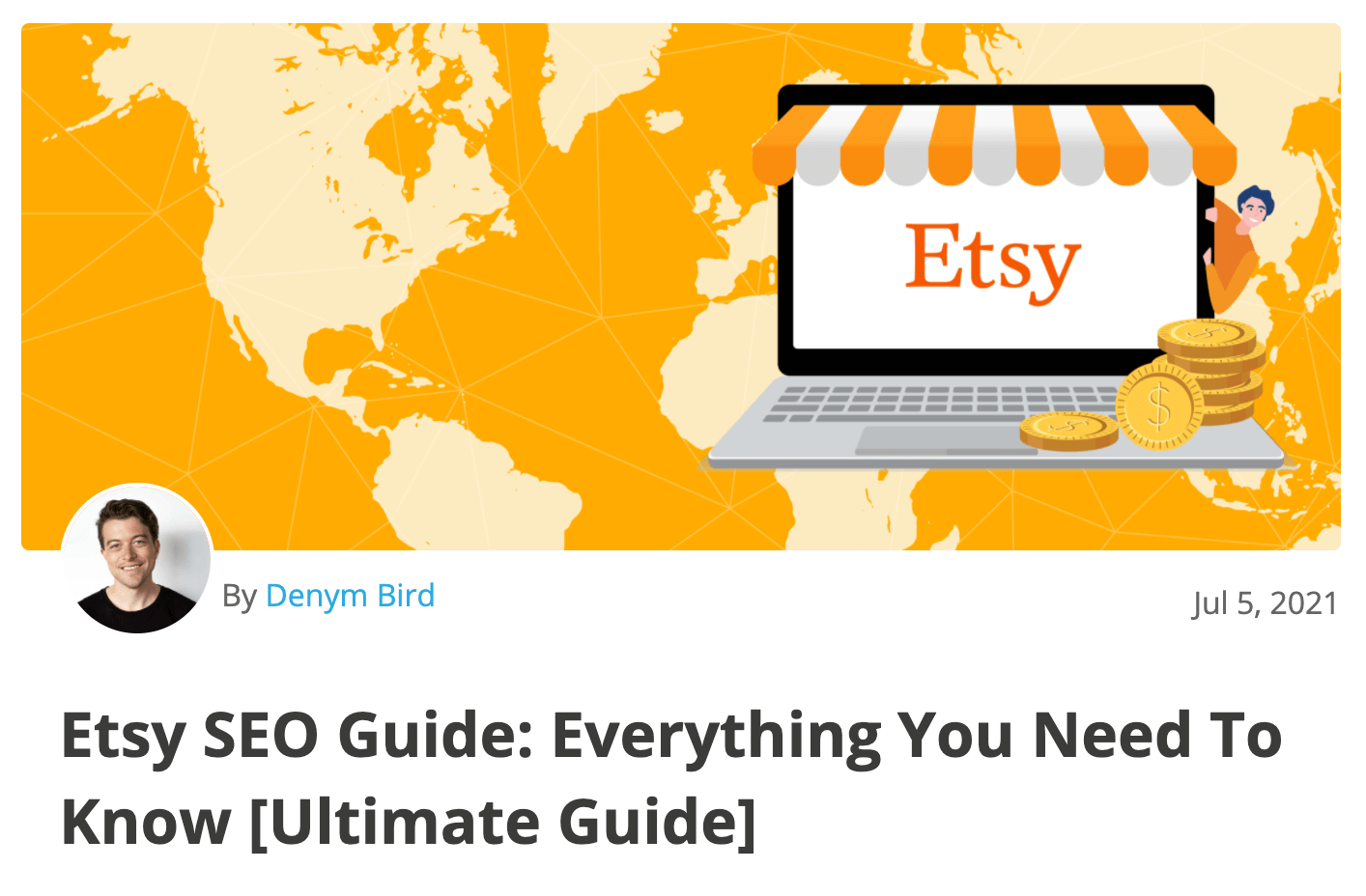
But the URL is simply: www.a2xaccounting.com/blog/etsy-seo/
- Take notice of your meta description. Just like the title tag, you want to make the description below it enticing to click on too. Sell your content, don’t be afraid to use power words like “amazing”, “fascinating”, and “insightful”, where appropriate. Just don’t get too click-baity, because whilst you might increase your CTR, you might also force people off the page too and that will hurt your performance in the long-run. Tools like SERP Portent can help generate a preview before you publish a piece of content.
The Google Search Console can tell you how your CTR looks for each page.
Focus on improving the pages with the poorest performance first.
Go deeper on organic CTR with this guide.Dwell time
| Factors that can increase your dwell time | |||
|---|---|---|---|
| Longer form content | PPT structure | Multimedia | Comments |
Dwell time is how long a visitor stays on your site before heading back to the search results page.
Dwell time is a good indicator to Google, and to you, of how interesting and relevant your page is to the visitors that land on it.
Low dwell time = not very.
This study by Moz found a direct correlation between rank and dwell time.
NB: Dwell time is similar to bounce rate, but they are different. A “bounce” is when a user leaves a website without interacting with any of the content. That’s next on the list.
There are some ways that you can improve your content to encourage longer dwell times:
- Write longer content. Providing high value, longform content will naturally increase your dwell time.
- Organize your content by PPT. Start any content with a preview, “this guide/article is about…”, followed by proof that it’s valuable or it works, and finish with a nice transition into your piece, like “let’s get started.”
- Add media. Videos can do wonders for your dwell time, as Wistia found when they saw a 260% increase in their dwell time.
- Allow comments and reply to them. Building a community and engaging with them on your posts can not only increase dwell time, but help you improve on your content and learn more about your site visitors too.
By also improving your core web vitals, you can ensure that your pages are loading quickly and not causing reductions in dwell time.
You can’t measure dwell time, exactly, but Google Analytics will give you the next best thing: Average Session Duration.
Learn more about dwell time and average session duration here.Bounce rate
| Factors that can decrease your bounce rate | |||||
|---|---|---|---|---|---|
| Compelling content | Easy to read and skim | Great design | Heatmap interactions | Internal linking | Mobile optimization |
The dwell time without any interactions. Bounce rates are when users visit your site but come back to Google without spending any time there.
You don’t want that.
The average bounce rate could be between 41-51%, but it seems that industry may impact this:
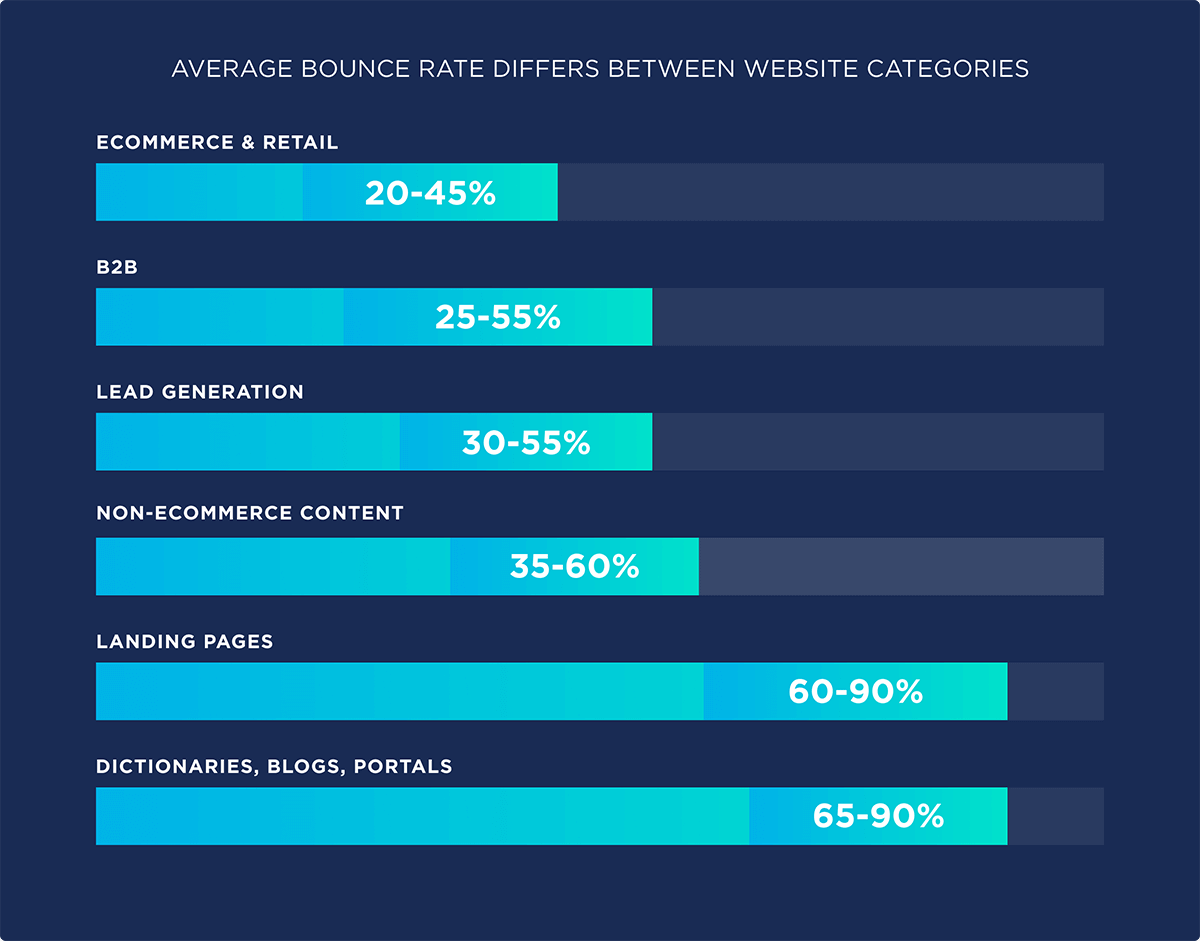 Source:
Backlinko.
Source:
Backlinko.See how high landing page bounce rates are? Spending time with this guide should help you improve yours and steer clear of, potentially, a 90% bounce rate.
If you have done everything in the preceding sections, then you’ll be well on your way to lower bounce rates already.
Other ways to keep visitors on your page:
- Make your content compelling. You want to catch your visitor’s eye, and intrigue them enough to stay on your page for a while.
- Make your content easy to read. Space it out, break it up and make it fun. People are generally time poor and skim reading your site, so make that easier for them.
- Use great design. Make your page a nice place to be. Aesthetics aren’t everything, but they are your visitor’s first impression.
- Use heatmaps. These show you where users really spend time, and where they don’t. The latter might be worth removing or tweaking.
- Use internal links. Link to other areas of your site. This improves SEO, and helps encourage visitors to stay within your ecosystem to find what they want.
- Optimize for mobile. Google now has a mobile-first index, and is looking for pages optimized for mobile users. With almost 60% of web traffic coming from mobile, it makes sense why. We’ll discuss this more in the next section: Content.
If you have matched the search intent of your user, you shouldn’t have too many issues with bounce rate.
Pogo-sticking
| Factors that can help discourage pogo-sticking | |||
|---|---|---|---|
| Relevant, comprehensive content | Easy navigation in longer-form pieces | Big, easy-to-read fonts | Internal links to other areas of your site |
Pogo-sticking is when a user needs to jump between a few sites to find what they’re looking for.
If the first-ranked page doesn’t satisfy their search query, then Google knows more about that site, and will likely push it down the results page.
You don’t want this for your target keywords. If you’re losing rank, this could be an indication that you’re not satisfying user intent.
Besides amazing content that satisfies search intent, here are ways to prevent pogo-sticking:
- Add internal links. These are links to other places in your own website so a user can look more deeply for their query with you - rather than bouncing back to Google.
- Use large, easy-to-read fonts. You want users to be able to skim, not have to squint. We’re talking 12-14pt upwards.
-
Add a
linked
table of
contents.
If you have
a
longer-form
blog or
piece of
content,
these tables
can help
people gauge
exactly what
the page is
about, and
jump to the
relevant
section
instantly.
We use
them in
A2X
blogs:
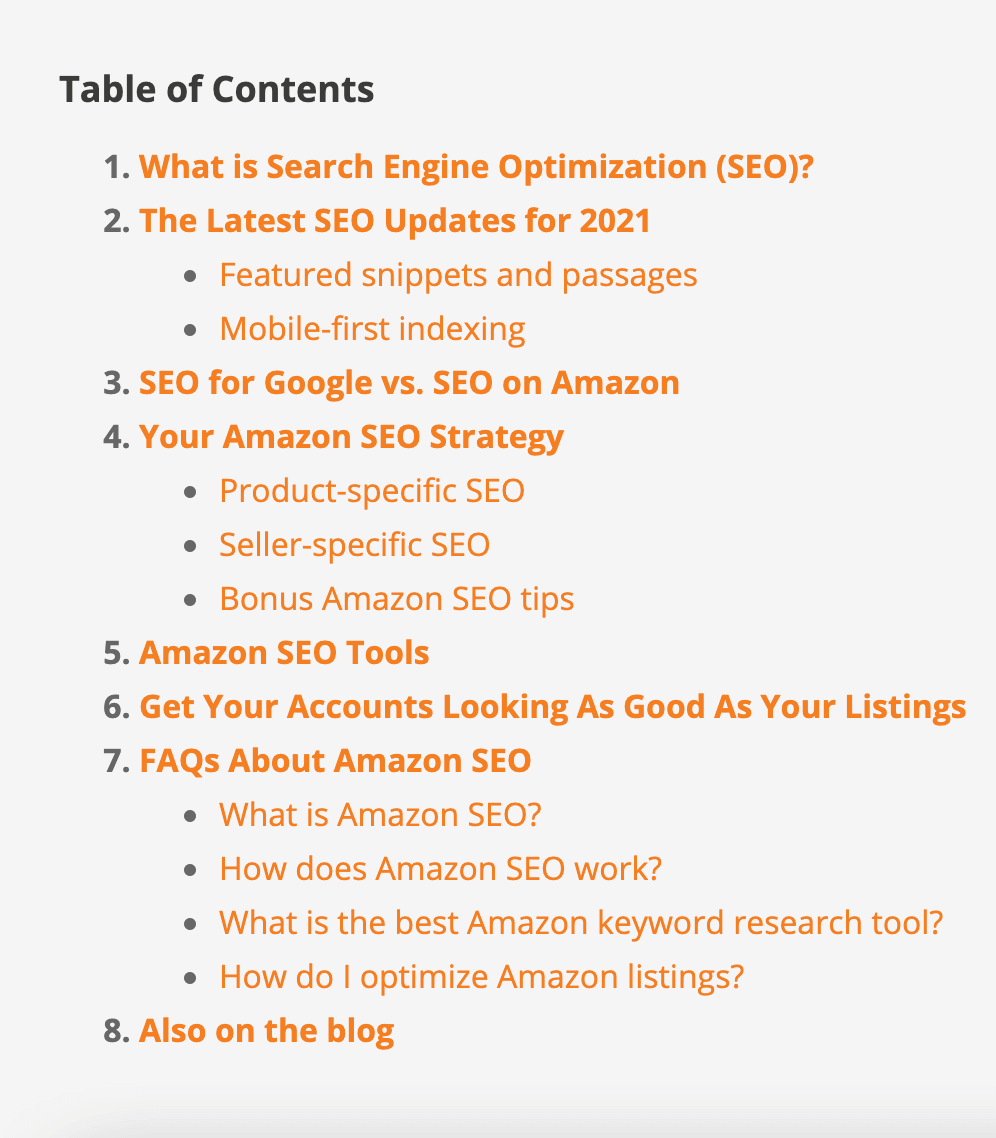
- Keep your content comprehensive and fresh. If people leave your site, it’s because you’re missing something, or perhaps it’s out of date. Make sure you cover everything relevant that you can in a topic, and that you keep updating it.
- Use accurate meta descriptions and titles. When people are scrolling through Google, they read the meta descriptions and titles to get an idea of what to expect on the page. By clearly describing what users can expect to find when they click, this helps to keep people on page for longer.
You’ll notice that a lot of these tips are the same or similar to those in other sections.
There’s really no secret to this stuff. Just produce great information that is up-to-date, easy to find and easy to read.
The Branches: Content
ON-PAGE SEO

What exactly is content?
Content is the substance of your website.
It is everything on the pages, from forms to blogs and service breakdowns. It can also be videos, audio, GIFs, infographics, concept visuals, graphs, charts and more.
It also happens to mean “satisfied”, or “pleased”, so think about that when you strategize the types of content on your site. Will it have that impact on your visitors?
Your pages will require different types of content, and they each need a unique approach.
That’s what this section is about.
First up, a disclaimer: you don’t need to be a brand or content strategist to pull this off well.
You know better than anyone what your potential clients will find helpful, so let that guide you alongside any research and data.
In the last section, under Search intent, we looked at the different kinds of search queries and what content they require. These consisted of informational, navigational, commercial and transactional content.
Here’s how these might translate to the pages of an accountant’s website:
| Information | Navigation | Commercial | Transaction |
|---|---|---|---|
|
Blogs Resources Tutorials |
About
and
contact
pages Contact information Social media links |
Service
offerings The apps and software you use (if applicable) |
Pricing
pages Request forms for quotes |
When you write your webpages, keep these intentions front of mind.
You may have some or all of these types of pages and content already, but are they optimized for search engines?
As an ecommerce accountant, your clients’ businesses are moving as fast as the technology that drives them.
That’s why it’s important for you to stay ahead of the game, and make sure that your content demonstrates just how cutting-edge and well-suited you are to help them thrive.
Whenever you come to create content, keep these best practices top of mind:
- Research keywords to find out what people want to know. We covered this above under User Experience > Search intent. Using tools like Ubersuggest, Keywords Everywhere, SEMRush and Ahrefs, you can get ideas for themes and discussion points relevant to your audience.
- Use those keywords to find out how people want to know it. Your audience might not want a long blog on a particular topic. They might prefer a list, a video, a graphic or something else. Look at what already ranks on Google. This indicates what is popular, and should inspire you too.
- Make sure your content is relevant, up-to-date, thorough, interesting and unique. Don’t skimp on any of these adjectives - they all matter! And it’s the only way to ensure that you produce better content than what’s already online, and get noticed by your audience and by Google.
- Make sure your content is optimized for mobile, too. Mobile experience is a huge focus for Google at the moment, with almost 60% of organic search engine traffic in the US coming from mobile. Learn more about it here.
It’s not rocket science, and yet content that covers all these bases is rare.
Which is great news for you. If you’ve got this far, you’re already well ahead.
The Leaves: Off-Site Credibility
OFF-PAGE SEO

Credibility and authority are gained online through backlinks.
Backlinks are when another website links (back) to yours.
If another site likes yours enough to recommend you, then that’s a good sign to Google.
It’s a vote of confidence, and that’s why it takes off-page SEO into account.
You can work on this just as much as the content on your own website.
As a business, you need to cover some essential bases to be visible online:
- List yourself on Google My Business. It’s easy to do, right here, and will mean you show up when someone uses a map to search for local options.
- Encourage, collect and display your reviews. You might find reviews of your services around the web. Encourage these, respond to them and link to/from the great ones whenever possible.
Then take it up a notch and encourage backlinking:
- Connect and network with other sites. By reaching out to similar sites or those that you like and link to, you can simply ask them to return the favor. You could even work on a resource together and promote it across your channels.
- Guest posting. Similar to the above, you could produce content for others in exchange for a mention and link back to your site. You might find they want to do the same on yours as well.
- Create assets that are irresistibly linkable. If you assemble a report or create a graphic that is original, insightful and useful, you may find other blogs or accountants linking to it in droves.
-
Ask to be included in link round-ups. A link round-up is one resource that compiles a list of others with links in one place. Look for link round-ups in your niche, and reach out to whomever produces the resource. Explain why your content is a good fit (and make sure that it is!)
You could even check what links are currently being used. Are any out of date? Is your resource a better version? You could suggest this (gently), and try appealing to them that way.
- Review accounting software or products that you like. If you have preferred products within your industry, writing a public review is another way to encourage a link back to your site. You could include this yourself, or companies will often try to do this to prove you’re real anyway.
Keep It Growing
No matter how much or how little of this you may come to implement in your own website, remember this: SEO is never “complete”.
Search engines change as user behavior changes which is constant, so optimizing for them is too.
Once you have your measuring tools in place, you can keep an eye on which areas of your website are particularly impactful and which are not.
There are plenty of ways to add value to your visitors and keep them coming back.
If you want more ideas for how to do this, and you haven’t already checked it out, head over to our accountants’ guide to attracting new clients.
In this resource, we dig deeper into marketing for accountants, how to find new leads and how to figure out what they want from you.
So once your new SEO strategy starts to bring in new leads, you’ll be ready for them, and you’ll know what to do to convert them to loyal, long-term customers.
Good luck!
Did you get here from the Ecommerce Accounting Hub? Go back to it here.